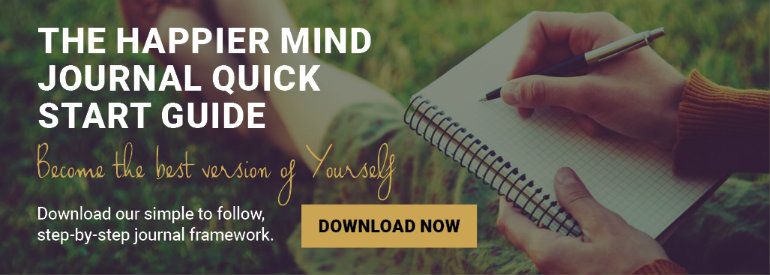 Reading Time: 5 minutes
Reading Time: 5 minutesWe’ve all been told to say thank you and count our blessings, but true gratitude goes much deeper. It requires mindfulness and intention. It becomes a way of life. And when it does — when you give gratitude this intentional focus, even for just five minutes a day — it has the power to heal you mentally, emotionally, and even physically.
Let’s talk about the science behind gratitude, and then I’ll show you a simple method for incorporating gratitude into your everyday life.
How Negative Emotions Physically Impact the Body
Negative emotions have tremendous power over your body because of the innate (and literal) connection between your body and your mind. According to a study published in Biological Psychiatry, sadness can make pain feel more intense than it is. Furthermore, anxiety and stress directly increase your risk of heart attack and stroke, respectively.
That’s not all: people who suffer from depression have higher levels of proteins that promote inflammation in the body, as well as increased accumulation of abdominal fat (which in turn increases risk of a myriad of health problems associated with being overweight or obese). One study even demonstrates that suppressing feelings also suppresses your immune system.
Robert Emmons, Ph.D., has done extensive work on cultivating gratitude as well as extended research on the benefits of that gratitude. His findings are remarkable:
- Those who keep a gratitude journal exercise more often, experience fewer unwanted physical symptoms and ailments, feel better, and are more optimistic than those who don’t.
- People who kept gratitude journals were more likely to achieve personal goals, including goals of physical health and well-being.
- Expressing daily gratitude resulted in increased alertness, determination, enthusiasm, energy, and attentiveness.
Additionally, and perhaps most notably, a study conducted on adults suffering from neuromuscular disease found that a three-week gratitude intervention increased their energy, improved their mood, made them feel more connected to those around them, gave them optimism, and helped them sleep longer and better.

Gobel Group takes this concept a step further in their white paper, Understanding Gratitude: The Connection Between Healing and Philanthropy. They describe the evidence that demonstrates patients who receive exceptional care feel gratitude. They then use that gratitude to fuel their own giving and philanthropy and experience immense physical benefit as a result, including reduced risk of heart disease, lower blood pressure, better cholesterol levels, improvement in body mass index, and more resilience to stress.
Another revealing study, Gratitude Research in Acute Coronary Events Study, found a remarkable difference between heart attack patients who were grateful and those who were less so: patients with high levels of gratitude were more compliant with their medications, chose healthier foods, were more physically active, experienced improved quality of life, and showed decreased rates of depression and anxiety.
What Kind of Gratitude Are We Talking About, Anyway?
Nothing crazy: simply taking five minutes each morning and again each night to ask yourself, “For what am I most grateful?” And then, when you answer that question, considering the full range of senses you experienced during those moments for which you’re grateful.

For example, let’s say today you’re grateful for a special moment with a loved one. When you reflect on that moment, consider the following:
- What did you see during that special moment? The look of affection in your loved one’s eyes, perhaps, or her hair cascading on her shoulders?
- What did you feel? The brush of his fingers on your waist or his eyelashes on your cheek?
- What did you hear? Rain or honking in the background? Words you hope to remember forever?
- What did you smell? A favorite cologne or the familiar smell of the bistro you sat in during this moment?
- What did you taste? Perhaps it was berry Chapstick or refreshing gum or a favorite wine?
How to Enact Gratitude
Enacting gratitude can be as simple as journaling for five to ten minutes twice a day, focusing on the people, connections, opportunities, and experiences for which you feel most grateful. Sometimes journaling comes naturally, but sometimes it’s hard. There will be days you’re not sure what to write and days you have a hard time identifying the blessings in your life.
These tips can help:
- Use a structured template with prompts. This makes it easier to fill in the blanks on those uninspired days.
- Give yourself permission to use the same things each time. If you’re grateful for a presence or opportunity in your life today, it’s very probable that you’ll be grateful for that same thing tomorrow, too — and that’s okay.
- Consider all areas of your life: family, health, wealth, career, faith, and intellect. Perhaps your life feels off-course in one or two areas — which can make it hard to feel grateful – but when you explore all areas you’re quickly reminded you have much to be thankful for.
The best possible advice I can give is to keep your eye on the prize: improved health, wealth, career, family, faith, and intellect that result from daily gratitude journaling. By focusing on what you want, you’ll stay motivated to do what it takes to get there.
And if you need help getting started, either download our free eBook or purchase a hardcover Happier Mind Journal with a 20% WLC discount. Use promotional code WLC20 at checkout.









